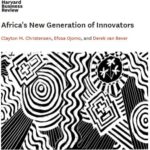 In the Harvard Business Review article, Africa’s New Generation of Innovators, Clayton Christensen, the father of disruption/disruptive innovation theory, and his co-authors put forth a belief that the choice between “pull” vs. “push” strategies is largely responsible for business success or failure in developing markets in Africa:
In the Harvard Business Review article, Africa’s New Generation of Innovators, Clayton Christensen, the father of disruption/disruptive innovation theory, and his co-authors put forth a belief that the choice between “pull” vs. “push” strategies is largely responsible for business success or failure in developing markets in Africa:
Why do so many multinationals run up against long-standing obstacles to success in developing markets, whereas other MNCs and local entrepreneurs succeed? We believe the answer lies in the difference between “push” and “pull” investment.
Push strategies are driven by the priorities of their originators and generate solutions that are imposed on markets and consumers. Pull strategies respond to needs represented in the struggles of everyday consumers.” — Christensen, Ojomo, & van Bever
As characterized by Christensen et al., businesses that utilize push strategies in African markets foist existing products onto consumers, often targeting the middle-class. These goods tend to bear the burden of pre-existing cost structures and attendant pricing that are at odds with widespread consumer adoption. And as competitors enter the market, these businesses face significant pressures on both margin and growth.
On the other hand, businesses that utilize pull strategies create markets by recognizing unmet consumer needs within the local context and developing affordable and accessible products that consumers actively bring into their lives.
Specifically, Christensen et al. find that ventures employing pull strategies tend to:
- sense unmet consumer needs and develop unique solutions,
- aggressively manage costs by integrating multiple elements of the activity chain,
- exhibit strong price discipline,
- and target everyday consumers at the base of the pyramid (as opposed to the middle-class).
While Christensen et al. highlight an example from the food industry (Tolaram Group’s Dufil Prima Foods, producers of Nigeria’s Indomie noodles) to explore how pull strategies can succeed in emerging markets, elements of pull strategies are increasingly leveraged by players in various sectors to innovate and compete effectively over the long term.
Iroko’s Evolution
Nigeria’s film industry, referred to as Nollywood, is second only to India’s Bollywood in terms of annual film production volume. Founded in 2010, IROKO, with over $40 million in total funding from the likes of New York’s Tiger Global, Sweden’s Kinnevik, and France’s Canal+, is a leading digital distributor of Nollywood content globally.
Throughout IROKO’s history, it has undergone several dramatic changes, some of which have brought it closer in alignment to the pull strategies described by Christensen.
Initially in 2011, IROKO derived 100% of its $1.2 million revenue from monetizing licensed content through Youtube’s Partner Program. However, in December 2011, the company launched IrokoTV.com, its proprietary video-on-demand platform. Founder & CEO Jason Njoku explains:
At first it was simply…NollywoodLove on Youtube — where without curation I simply bought and uploaded, fast and furiously, as many movies as I could get my hands on and monetized with adverts…My ambitions far outweighed what I could achieve on YouTube and thus started the mass migration of a million dollar business away from YouTube.
By mid-2013, over 50% of IROKO’s revenue came from the IrokoTV platform, while revenue from Youtube amounted to less than 15%. Initially, IrokoTV employed a freemium model with its audience enjoying free access to advertising-supported lower-tier content and paid access to premium content (IrokoTV PLUS). By the end of 2013, despite paying subscribers representing less than 3% of IROKO’s global monthly audience, IROKO’s paid subscription business, IrokoTV PLUS, became the business’ main revenue driver.
By Q2 2014, paying subscribers had grown to 5% of its global audience and in April 2014, the company announced that it was embracing a subscription-only model wherein the free, advertising-supported IrokoTV option would be discontinued in 140 of its 170 revenue-generating countries:
I am literally betting the entire company and millions of dollars of revenue on a dramatic shift to a paid only model…We start with 140 countries but expect to migrate everything over in the near future. —Jason Njoku
In addition to identifying its core business model for IrokoTV, in 2014 IROKO also defined its core audience:
When I think of the future of IrokoTV, I can only really see Africa and specifically Nigeria as our big markets…Africa is no longer the future. Africa is now. —Jason Njoku
At the start of 2014, Africa represented only 2% of paying IrokoTV subscribers. By early 2015 however, African subscribers grew over 450% year-on-year to represent 11% of the IrokoTV subscriber base (with Nigeria being the fastest growing market globally).
 Having determined its core business model and customer base, IROKO moved towards further integration of its activity chain. In Q3 2014, it launched ROK Studios, an in-house production and financing studio that gives IROKO greater control over the cost and quality of content. (In September 2016, ROK Studios partnered with SKY, the largest PayTV operator in Europe, to launch ROK TV, a 24/7 Nollywood channel fully programmed, produced, and developed by ROK Studios.)
Having determined its core business model and customer base, IROKO moved towards further integration of its activity chain. In Q3 2014, it launched ROK Studios, an in-house production and financing studio that gives IROKO greater control over the cost and quality of content. (In September 2016, ROK Studios partnered with SKY, the largest PayTV operator in Europe, to launch ROK TV, a 24/7 Nollywood channel fully programmed, produced, and developed by ROK Studios.)
We started off licensing movies for $100. Fast forward 3 years, we now license movies for four to ten, fifty-thousand dollars at times. So we spend a significant amount of our budget on content — $3-$4 million a year on content.
So at core, we’re a content company…[and] because we own the platform…we have thousands of [data points]…For example, I know the top 20 most-queried actors and actresses in Nollywood and that enables me to say ‘in these movies that we’re producing, we want those people in there, not because we think they’re popular but because we can see from the data that those guys are popular.’
Our goal for ROK Studios is stupidly simple: we want to improve the quality of Nollywood movies being made… in time, we will be able to produce 200 movies a year ourselves. —Jason Njoku
IROKO also moved to better align its product offerings with the needs of its core audience. In March 2015, in response to unique user behavior driven by issues around the cost, quality, and availability of broadband data across its African markets, IROKO launched a new feature for its IrokoTV platform: it allowed subscribers to download data-optimized, DRM-protected content for offline viewing.
In Nigeria (and Africa), peak viewing is between 10am — 5pm: office hours. During this time, the ISP networks people are using are enterprise level data. This is the opposite [of] every other [Western] market. Yet we believe viewing patterns globally are similar. The difference is/was data availability. —Jason Njoku
By July 2015, IROKO fully embraced on-the-ground realities in its revenue-generating African markets. It focused its product and engineering teams around mobile and the Android platform, and it required users of the IrokoTV app to download content before viewing, a departure from the immediate gratification of traditional streaming that consumers with access to affordable, high-quality networks in Western markets were used to. (IROKO later enabled progressive downloads, the ability to play content before downloading is completed, for users outside of Africa.)
We took one of the most ambitious steps in trying to solve the largest challenge for unlocking growth for our African viewers: accessing content. The dawn of the download began…
Unlocking growth in Africa is our only reality. It’s where the market has always been, hence we begin to distort the product to this reality. —Jason Njoku
In addition to aligning product features to market realities in Africa, IROKO has also taken an experimental approach to understanding consumer preferences and adjusting its pricing accordingly, with heterogenous pricing for African vs. Western markets and mobile-only vs. mobile/desktop users:
Consumer Internet in Africa is new…New customers need new prices, so our Africa mobile-only customers will receive one. We are building for folks without electricity…[so we] have to stay experimental…We still don’t have the definitive answers to Africa pricing yet. We’re still figuring it out. —Jason Njoku
Embracing the Base of the Pyramid
As IROKO has evolved through the years, it increasingly exhibits elements of the pull strategies described by Christensen: aggressive cost management through activity chain integration, strong price discipline, identification and addressing of unmet consumers needs, and heightened focus on everyday consumers at the base of the pyramid.
Activity Chain Integration
Early in its history, IROKO focused on the middle of the digital distribution supply chain. While it converted content into digital formats, indexed and provided content metadata, and uploaded content for consumer consumption, it did not produce any content (instead amassing a catalog of content licensed from rights owners), nor did it control the customer experience (instead outsourcing end-delivery of content to Youtube).
True to Christensen et al.’s observation that successful innovators in emerging markets “integrat[e] as many elements of the activity chain as possible,” IROKO has since integrated its operations both forward and backward.
To exert more control over the customer experience and customer relationship, it launched the IrokoTV web platform in 2011 and its first mobile app in 2013, and it continues to move away from third-party technical partners to an in-house technology infrastructure that allows it the nimbleness and flexibility to react to market conditions in what the CEO calls ‘Internet time.’
Moreover, to better control its costs & supply of content, in 2014 it launched ROK Studios, a data-driven, in-house content production unit that allows it to bypass costly content licenses, and in 2016 it launched IrokoX, a platform that provides content creation, distribution, and monetization support to independent third-party producers in exchange for 20% of revenues.
Price Strategy & Discipline
Christensen et al. warn companies who hope to achieve breakout growth in developing markets against “set[ting] prices at levels that limit market penetration.”
IROKO, as a venture-backed company focused on rapid growth, has taken this to heart, incorporating a growth & experimentation mindset into its pricing strategy.
For example, the company noticed the popularity of individually packaged CPG (consumer packaged goods) items which, while cheaper on an absolute basis, were more expensive on a per-unit basis than bundled items. Leveraging this insight, the company introduced unlimited weekly Android access to IrokoTV for 100 Nigerian naira which resulted in 100% growth in Nigerian subscribers within the first 30 days. (In comparison, the equivalent weekly cost of the company’s annual package is less than 60 Nigerian naira.)
We don’t use margins structures when we think about pricing, we think about what the customer can legitimately afford…[and we work] to reduce the entry level price for IROKOtv in Africa. We’re growing the market. —Jason Njoku
Unique Solutions for Unique Consumer Needs
After IROKO developed its proprietary web and mobile IrokoTV platform, it noticed unique behavior from its African audience and ultimately sought out and discovered the underlying cause: high costs of data and poor bandwidth capacity. Indeed, the company has repeatedly said that the major challenge it faces in Africa is the ‘data burden’ which limits the ability of its target audience to consume IrokoTV’s content.
In response, the company has taken and continues to take steps to mitigate this issue. It moved away from streaming towards downloads, tasked its product and engineering teams to find technical solutions around data compression, and most recently it launched a kiosk & agent network across Lagos, Nigeria that will allow subscribers to visit any one of 100 locations and receive DRM-protected, IrokoTV content without need for broadband data using Wifi Direct technology:
There are peculiarities which you have to embrace, otherwise you can’t win in the local market here. We’re going to go that extra mile because we are here and we know what it’s about…
We believe in the Nollywood community. What we are now doing is building future features which bring the communities closer together. But those features need folks to be educated — they need their hands to be held. Hence the introduction of the kiosks…
We have 65 deployed with a further 35 being deployed in Q1 [2017]…The core purpose of the kiosks are pretty simple: Customer Education; Product Evangelism; Product Customer Support; Transactions (collecting cash/facilitating mobile wallet, etc.); [and] Data Free Downloads (DRM protected). —Jason Njoku
Targeting Customers At the Base of the Pyramid
Broadly speaking, IROKO’s evolution throughout the years has seen it de-emphasize Western markets to focus on African consumers given its belief that its future opportunity is larger there:
The only reason we are large outside of [Africa] is because of terrible internet penetration on the continent. But that will change…We need to build the future.
African Diaspora = 30m. ~4m watch Nollywood. Sub-saharan Africa = 850m. ~150–200m watch Nollywood. —Jason Njoku
As it continues to adjust its product, pricing, and distribution strategies for the African market, IROKO increasingly serves average Africans rather than the middle class:
Our community, our folks who watch Nollywood, primarily live in the base of the pyramid…[They] aren’t necessarily tech savvy. But they are our people. —Jason Njoku
Looking Forward
Christensen et al.’s framework of push vs. pull strategies is useful for exploring the activities of businesses operating in Africa. Moreover, Christensen and his co-authors believe that “documenting, analyzing, and teaching the essentials” of market-creating innovators in Africa that utilize pull strategies could have a significant impact on “entrepreneurs in Africa and on the lives and welfare of people throughout the world’s emerging economies.” To that end, this analysis of IROKO was conducted.
While IROKO clearly views its consumer subscription video-on-demand (SVOD) business, IrokoTV, as key to its future, IROKO has diversified into eight distinct but related businesses, none of which represent more than 35% of total revenue:
 In addition to the IrokoTV, ROK Studios, and IrokoX business units mentioned above, the company operates a thriving multi-channel licensing division, Iroko Global; a business unit focused on French-speaking Africa, Iroko+; a popular platform for digital music, iROKING; and two additional divisions, ROK and Iroko Networks.
In addition to the IrokoTV, ROK Studios, and IrokoX business units mentioned above, the company operates a thriving multi-channel licensing division, Iroko Global; a business unit focused on French-speaking Africa, Iroko+; a popular platform for digital music, iROKING; and two additional divisions, ROK and Iroko Networks.
IROKO’s ultimate goal is to build a billion dollar business, and as it continues to embrace African consumers and create new markets for digital consumption of Nollywood content, it seems a significant part of its value will be created by consumers at the base of the pyramid.
If you enjoyed this article, subscribe to be notified when more like it are published.




Share: